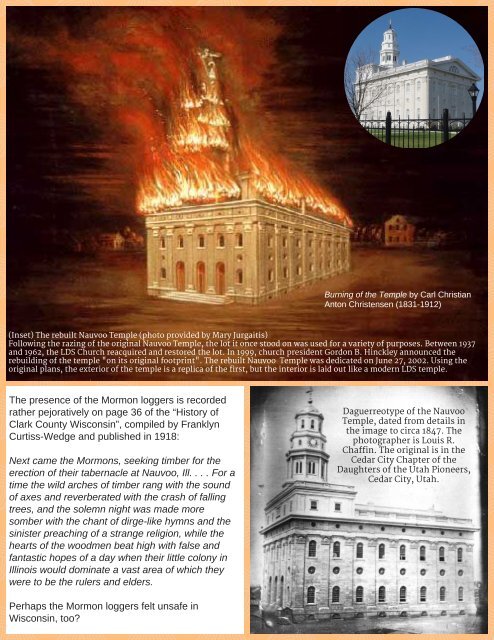ON THIS SPOT _ Issue 1
From the Lake Michigan shoreline to the banks of the Mississippi River, from Bayfield to Beloit, the Union's 30th state boasts an eclectic, fascinating, impressive history that is often overlooked in favor of the east coast colonies. From the first peoples who have cherished the land from time immemorial; to the arrival of the French explorers, "voyageurs" and Catholic missionaries in the 1600's; to the pioneer settlers who arrived in droves from the late-1700's to the mid-1800's, Wisconsin's history has been shaped by an enviable array of people, places, cultures, languages, and events that influence residents and visitors even today. Through interviews with those who placed the markers, ON THIS SPOT augments the popular WisconsinHistoricalMarkers.blogspot.com website and provide readers with a deeper understanding of the history briefly recounted in a marker's content, such that, when in the area, readers may be inspired to "stop and visit the spot".
From the Lake Michigan shoreline to the banks of the
Mississippi River, from Bayfield to Beloit, the Union's 30th state
boasts an eclectic, fascinating, impressive history that is often
overlooked in favor of the east coast colonies. From the first peoples
who have cherished the land from time immemorial; to the arrival of
the French explorers, "voyageurs" and Catholic missionaries in the
1600's; to the pioneer settlers who arrived in droves from the
late-1700's to the mid-1800's, Wisconsin's history has been shaped
by an enviable array of people, places, cultures, languages, and
events that influence residents and visitors even today.
Through interviews with those who placed the markers, ON THIS
SPOT augments the popular WisconsinHistoricalMarkers.blogspot.com website and provide readers with a deeper understanding
of the history briefly recounted in a marker's content,
such that, when in the area, readers may be
inspired to "stop and visit the spot".
You also want an ePaper? Increase the reach of your titles
YUMPU automatically turns print PDFs into web optimized ePapers that Google loves.
Burning of the Temple by Carl Christian<br />
Anton Christensen (18311912)<br />
(Inset) The rebuilt Nauvoo Temple (photo provided by Mary Jurgaitis)<br />
Following the razing of the original Nauvoo Temple, the lot it once stood on was used for a variety of purposes. Between 1937<br />
and 1962, the LDS Church reacquired and restored the lot. In 1999, church president Gordon B. Hinckley announced the<br />
rebuilding of the temple "on its original footprint". The rebuilt Nauvoo Temple was dedicated on June 27, 2002. Using the<br />
original plans, the exterior of the temple is a replica of the first, but the interior is laid out like a modern LDS temple.<br />
The presence of the Mormon loggers is recorded<br />
rather pejoratively on page 36 of the “History of<br />
Clark County Wisconsin”, compiled by Franklyn<br />
CurtissWedge and published in 1918:<br />
Next came the Mormons, seeking timber for the<br />
erection of their tabernacle at Nauvoo, Ill. . . . For a<br />
time the wild arches of timber rang with the sound<br />
of axes and reverberated with the crash of falling<br />
trees, and the solemn night was made more<br />
somber with the chant of dirgelike hymns and the<br />
sinister preaching of a strange religion, while the<br />
hearts of the woodmen beat high with false and<br />
fantastic hopes of a day when their little colony in<br />
Illinois would dominate a vast area of which they<br />
were to be the rulers and elders.<br />
Daguerreotype of the Nauvoo<br />
Temple, dated from details in<br />
the image to circa 1847. The<br />
photographer is Louis R.<br />
Chaffin. The original is in the<br />
Cedar City Chapter of the<br />
Daughters of the Utah Pioneers,<br />
Cedar City, Utah.<br />
Perhaps the Mormon loggers felt unsafe in<br />
Wisconsin, too?


